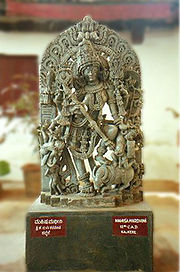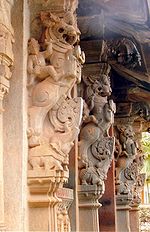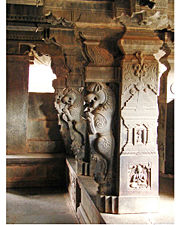
Shivappa Nayaka
Encyclopedia



Keladi Nayaka
Keladi Nayaka Kingdom were an important ruling dynasty of post-medieval Karnataka, India. They initially started to rule as a feudatory of the Vijayanagar Empire...
Kingdom. The Keladi Nayakas were successors of the Vijayanagara Empire
Vijayanagara Empire
The Vijayanagara Empire , referred as the Kingdom of Bisnaga by the Portuguese, was an empire based in South Indian in the Deccan Plateau region. It was established in 1336 by Harihara I and his brother Bukka Raya I of the Yadava lineage. The empire rose to prominence as a culmination of attempts...
in the coastal and Malnad
Malnad
Malenadu is a region of Karnataka state in South India. Malenadu covers the western and eastern slopes of the Western Ghats, roughly 100 kilometers in width. Malenadu covers portions of the Shimoga, Chikmagalur, Uttara Kannada, Kodagu and Hassan districts....
(hill) districts of Karnataka
Karnataka
Karnataka , the land of the Kannadigas, is a state in South West India. It was created on 1 November 1956, with the passing of the States Reorganisation Act and this day is annually celebrated as Karnataka Rajyotsava...
, India, in the late 16th century. At their peak, the Nayakas built a niche kingdom comprising the coastal, hill and some interior districts (Bayaluseeme) of modern Karnataka, before succumbing to the Kingdom of Mysore
Kingdom of Mysore
The Kingdom of Mysore was a kingdom of southern India, traditionally believed to have been founded in 1399 in the vicinity of the modern city of Mysore. The kingdom, which was ruled by the Wodeyar family, initially served as a vassal state of the Vijayanagara Empire...
ruled by Hyder Ali
Hyder Ali
Hyder Ali was the de facto ruler of the Kingdom of Mysore in southern India. Born Hyder Naik, he distinguished himself militarily, eventually drawing the attention of Mysore's rulers...
in 1763. He was known as Sistina Shivappa Nayaka because he introduced a tax
Tax
To tax is to impose a financial charge or other levy upon a taxpayer by a state or the functional equivalent of a state such that failure to pay is punishable by law. Taxes are also imposed by many subnational entities...
system called Sist.
Conquests
Shivappa Nayaka is remembered as an able administrator and soldier. He ascended the throne in 1645. During this time, the last ruler of the diminished Vijayanagara Empire ruling from VelloreVellore
Vellore It is considered one of the oldest cities in South India and lies on the banks of the Palar river on the site of Vellore Fort. The city lies between Chennai and Bangalore and the Temple towns of Thiruvannamalai and Tirupati...
, Shriranga Raya III was defeated by the Bijapur Sultanate and sought refuge with Shivappa. The growing threat of the Portuguese
Portugal
Portugal , officially the Portuguese Republic is a country situated in southwestern Europe on the Iberian Peninsula. Portugal is the westernmost country of Europe, and is bordered by the Atlantic Ocean to the West and South and by Spain to the North and East. The Atlantic archipelagos of the...
was eliminated by 1653 and the ports of Mangalore
Mangalore
Mangalore is the chief port city of the Indian state of Karnataka. It is located about west of the state capital, Bangalore. Mangalore lies between the Arabian Sea and the Western Ghat mountain ranges, and is the administrative headquarters of the Dakshina Kannada district in south western...
, Kundapura
Kundapura
-Languages and culture :The town mainly consists of Kannadigas who speak Kundagannada, Konkanis and Tuluvas. The Goud Saraswat Brahmins who fled Goa during the Portuguese arrival in the 16th century arrived by Boat in Basrur and some settled in Kundapura and surrounding villages. These people and...
and Honnavar were brought under Keladi control. Having conquered the Kannada coast, he marched down to Kasargod region of modern Kerala
Kerala
or Keralam is an Indian state located on the Malabar coast of south-west India. It was created on 1 November 1956 by the States Reorganisation Act by combining various Malayalam speaking regions....
and installed a pillar of victory at Nileshvara. The forts of Chandragiri, Bekal
Bekal
-References:* *...
and Mangalore were built by Shivappa Nayaka.
Later he invaded north of the Tungabhadra river and captured territory in the modern Dharwad district
Dharwad District
Dharwad District is an administrative district of the state of Karnataka in southern India. Dharwad is the cultural headquarters of North Karnataka....
from the Bijapur Sultanate. In the south, when he invaded and laid siege to Srirangapatna
Srirangapatna
Srirangapatna is a town in Mandya district of the Indian state of Karnataka...
in modern Mysore district
Mysore district
Mysore District is an administrative district located in the southern part of the state of Karnataka, India. The district is bounded by Mandya district to the northeast, Chamrajanagar district to the southeast, Kerala state to the south, Kodagu district to the west, and Hassan district to the north...
, an epidemic broke out in his army forcing him the withdraw.
Administrator
Shivappa Nayaka introduced a revenue settlement scheme called Sist, a policy that has found favourable comparison to revenue schemes formulated by the MogulMughal Empire
The Mughal Empire , or Mogul Empire in traditional English usage, was an imperial power from the Indian Subcontinent. The Mughal emperors were descendants of the Timurids...
emperor Akbar. According to this scheme, agricultural lands were divided into five types depending on the type of soil and available irrigational facilities. A unit of sowing capacity called Khanduga was developed and every irrigable land was taxed in varying amounts based on this unit. The rate of taxation depended on the yield in each one of these five types of land, the rate varying from village to village and amounting to a third of the total yield. Shivappa Nayaka gave importance to agriculture which resulted in an expanding agrarian economy. A religious and tolerant man, Shivappa Nayaka performed Vedic
Historical Vedic religion
The religion of the Vedic period is a historical predecessor of Hinduism. Its liturgy is reflected in the mantra portion of the four Vedas, which are compiled in Sanskrit. The religious practices centered on a clergy administering rites...
sacrifices and rituals and patronised the Hindu
Hindu
Hindu refers to an identity associated with the philosophical, religious and cultural systems that are indigenous to the Indian subcontinent. As used in the Constitution of India, the word "Hindu" is also attributed to all persons professing any Indian religion...
Advaita order of Sringeri. He was tolerant towards Christian
Christian
A Christian is a person who adheres to Christianity, an Abrahamic, monotheistic religion based on the life and teachings of Jesus of Nazareth as recorded in the Canonical gospels and the letters of the New Testament...
s and gave them land to cultivate. He encouraged the mercantile communities of South India such as the Komatis and Konkani
Konkani people
Konkani people , form a group of people mainly found in the Konkan Coast of western India whose mother-tongue is the Konkani language....
s to settle down and establish businesses in his kingdom.
An interesting episode from the time of Shivappa Nayaka's rule goes as follows. A poor man called Ganesh Mallya came to Keladi, the capital city, with the intention of finding a job. Having no money, he carried a bag full of home-grown coconuts. Before entering the city, every traveller had to pass through eight toll gates, each of which collected a tax. Because he carried no cash, Ganesh Mallya had to part with two coconuts at each toll gate, one as tax and the other as a gift to the official. He also paid with two coconuts at the city entrance. Frustrated with all the tolls, Mallya boldly set up his own toll gate (the ninth toll gate) and collected a toll after registering full details of travellers into the city in his own register. In return for the toll, Ganesh Mallya handed out a receipt with a note new custom station for eighteen coconuts, signature of Ganeshayya Raja of Kumta. This went on unnoticed for eighteen months before King Shivappa Nayaka heard of it. When summoned by the king, Ganesh Mallya admitted he had collected an illegal toll to make a livelihood. Impressed by his honesty and business acumen, Shivappa Nayaka took Ganesh Mallya into his service.
Shivappa Nayaka was succeeded on the throne by his younger brother Chikkavenkatappa Nayaka in 1660.

